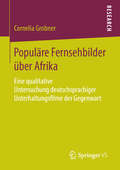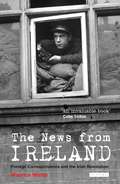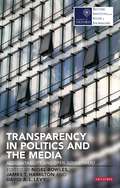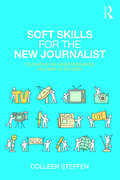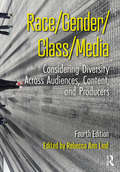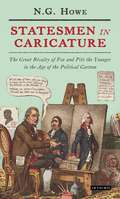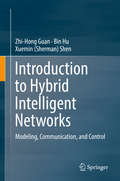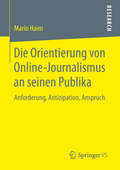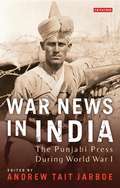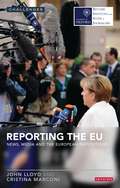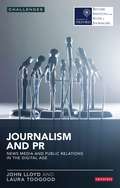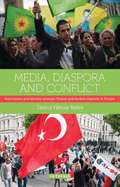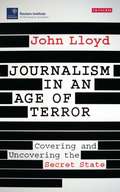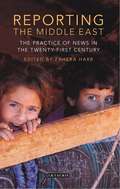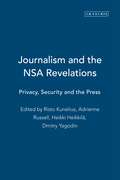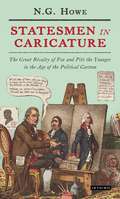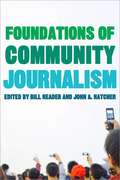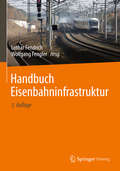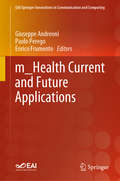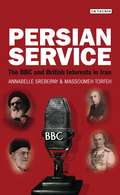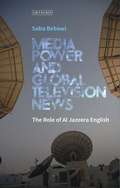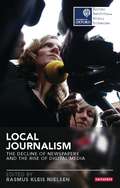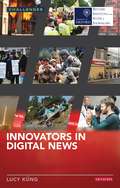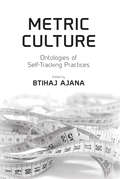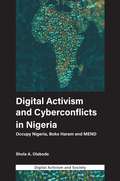- Table View
- List View
Populäre Fernsehbilder über Afrika: Eine qualitative Untersuchung deutschsprachiger Unterhaltungsfilme der Gegenwart
by Cornelia GrobnerWelchen Beitrag leisten populäre Fernsehbilder zur symbolischen Grenzziehung zwischen Mehrheitsbevölkerung und marginalisierten Gesellschaftsgruppen? Cornelia Grobner zeigt dies exemplarisch anhand einer qualitativen Untersuchung von deutschsprachigen Unterhaltungsfilmen mit afrikanischen Handlungsorten sowie ihrem Publikum. Ihre Studie wirft – im Spannungsfeld von Fremde und Heimat – neue Perspektiven auf Zusammenhänge zwischen fiktionalen Fernsehbildern, Rezeptionsweisen und gesellschaftlichen Wirklichkeiten.
The News from Ireland: Foreign Correspondents and the Irish Revolution
by Maurice WalshThe Anglo-Irish war of 1919-1921 was an international historical landmark: the first successful revolution against British rule and the beginning of the end of the Empire. But the Irish revolutionaries did not win their struggle on the battlefield - their key victory was in mobilising public opinion in Britain and the rest of the world. Journalists and writers flocked to Ireland, where the increasingly brutal conflict was seen as the crucible for settling some of the key issues of the new world order emerging from the ruins of the First World War. On trial was the British Empire's claim to be the champion of civilisation as well as the principle of self-determination proclaimed by the American president Woodrow Wilson."The News from Ireland" vividly explores the work of British and American correspondents in Ireland as well as other foreign journalists and literary figures. It offers a penetrating and persuasive assessment of the Irish revolution's place in a key moment of world history as well as the role of the press and journalism in the conflict.This important book will be essential reading for anyone interested in Irish history and how our understanding of history generally is shaped by the media.
Transparency in Politics and the Media: Accountability and Open Government
by Nigel Bowles James T. Hamilton David A. LevyIncreasingly governments around the world are experimenting with initiatives in transparency or 'open government'. These involve a variety of measures including the announcement of more user-friendly government websites, greater access to government data, the extension of freedom of information legislation and broader attempts to involve the public in government decision making. However, the role of the media in these initiatives has not hitherto been examined. This volume analyses the challenges and opportunities presented to journalists as they attempt to hold governments accountable in an era of professed transparency. In examining how transparency and open government initiatives have affected the accountability role of the press in the US and the UK, it also explores how policies in these two countries could change in the future to help journalists hold governments more accountable. This volume will be essential reading for all practising journalists, for students of journalism or politics, and for policymakers.
Soft Skills for the New Journalist: Cultivating the Inner Resources You Need to Succeed
by Colleen SteffenJournalism is a pool staffed by distracted lifeguards and no matter how fancy your school is, your first week in a real newsroom will feel like a shove in the small of the back into 15 feet of water. Most of us come up for air eventually, but if you’re like journalist and educator Colleen Steffen, you may still be left feeling like all that training in inverted pyramids and question lists left something important out: you! Journalism is people managing, wrestling truth and story out of the messy, confusing raw material that is a human being, and the messiest human involved can often be the reporter themselves. So it’s time to talk about it. Instead of nervously skirting the sizable EQ (emotional intelligence) portion of this IQ (intelligence intelligence) enterprise, Soft Skills for the New Journalist explores how it FEELS to do this strange, hard, amazing job—and how to use those feelings to better your work and yourself.
Race/Gender/Class/Media: Considering Diversity Across Audiences, Content, and Producers
by Rebecca Ann LindRace/Gender/Class/Media considers diversity in the mass media in three main settings: Audiences, Content, and Production. It brings together 53 readings—most are newly commissioned for this edition—by scholars representing a variety of social science and humanities disciplines. Together, these readings provide a multifaceted and often intersectional look at how race, gender, and class relate to the creation and use of media texts as well as the media texts themselves. Designed to be flexible in the classroom, the book begins with a detailed introduction to key concepts and presents a contextualizing introduction to each of the three main sections. Each reading contains multiple It’s Your Turn activities to foster student engagement and which can serve as the basis for assignments. The book offers a list of resources—books, articles, films, and websites—that are of value to students and instructors. Several alternate Tables of Contents are provided as options for reorganizing the material and maximizing the flexibility of the readings: by site of struggle (gender, race, class), by medium (television, print, digital, etc.), and by arena (journalism, entertainment). This volume is an essential introduction to interdisciplinary studies of gender, race, and class across mass media.
Statesmen in Caricature: The Great Rivalry of Fox and Pitt the Younger in the Age of the Political Cartoon (International Library of Political Studies)
by N. G. HoweThe years 1780 to 1820 have long been seen as the Golden Age of the English satirical print. This period witnessed a number of changes in style which had far-reaching consequences, including an increase in the effectiveness of the caricature as visual propaganda. William Pitt the Younger and Charles James Fox were the leading politicians of the age, continuing a family rivalry begun by their fathers. They were amongst the most caricatured men of their time and became emblems of the two sides of the political debate whilst gathering personal followings, based upon personality rather than filial or political patronage. Fox and Pitt the Younger came to represent a more modern notion of the party leader, in an age before formalized political parties and structures. Neil Howe here shows how `stock images' came to the fore and examines the central role they played within the visual representation of politicians during the late-eighteenth century. His book also chronicles how the biggest political rivalry of the age played out within contemporary caricature, from the emergence of Fox and Pitt as big political beasts in the wake of the American Revolution, though the East India Bill Crisis; Regency Crisis and French Revolution to the death of both men in 1806.
Introduction to Hybrid Intelligent Networks: Modeling, Communication, and Control
by Zhi-Hong Guan Bin Hu Xuemin Sherman ShenThis book covers the fundamental principles, new theories and methodologies, and potential applications of hybrid intelligent networks. Chapters focus on hybrid neural networks and networked multi-agent networks, including their communication, control and optimization synthesis. This text also provides a succinct but useful guideline for designing neural network-based hybrid artificial intelligence for brain-inspired computation systems and applications in the Internet of Things.Artificial Intelligence has developed into a deep research field targeting robots with more brain-inspired perception, learning, decision-making abilities, etc. This text devoted to a tutorial on hybrid intelligent networks that have been identified in nature and engineering, especially in the brain, modeled by hybrid dynamical systems and complex networks, and have shown potential application to brain-inspired intelligence. Included in this text are impulsive neural networks, neurodynamics, multiagent networks, hybrid dynamics analysis, collective dynamics, as well as hybrid communication, control and optimization methods. Graduate students who are interested in artificial intelligence and hybrid intelligence, as well as professors and graduate students who are interested in neural networks and multiagent networks will find this textbook a valuable resource. AI engineers and consultants who are working in wireless communications and networking will want to buy this book. Also, professional and academic institutions in universities and Mobile vehicle companies and engineers and managers who concern humans in the loop of IoT will also be interested in this book.
Die Orientierung von Online-Journalismus an seinen Publika: Anforderung, Antizipation, Anspruch
by Mario HaimIm Internet stehen dem Journalismus zahlreiche Möglichkeiten der Beobachtung seiner Publika zur Verfügung. Mario Haim geht der Frage nach, ob und inwiefern sich solche Informationen – Klick- und Share-Zahlen etwa – auf Redaktionen, Journalistinnen und Journalisten sowie journalistische Produkte auswirken. Denn die Bedeutung von Publika ist für den Journalismus im Internet gestiegen, nicht zuletzt aufgrund ökonomischer Probleme sowie des großen Einflusses durch Intermediäre. Für die vorliegende Untersuchung der Orientierung an Publika im Online-Journalismus setzt der Autor auf ein umfangreiches quantitativ-automatisiertes Erhebungsverfahren sowie ergänzende Leitfadeninterviews. Es zeigt sich, dass sich Redaktionen vielfach nach Klickzahlen, Nutzungszeiten und Zugangswegen richten. Journalistinnen und Journalisten sehen sich mit veränderten Ansprüchen an ihr Schaffen konfrontiert, die sich durch eine ständige Beobachtung der Publika mit vermeintlicher empirischer Evidenz untermauern lassen.
War News in India: The Punjabi Press During World War I
by Andrew Tait JarboeThe Punjab region of India sent more than 600,000 combatants to assist the British war effort during World War I. Their families back home, thousands of miles from the major scenes of battle, were desperate for war news, and newspapers provided daily reports to keep the local population up-to-date with developments on the Western Front. This book presents the first English-language translations of hundreds of articles published during World War I in the newsapers of the Punjab region. They offer a lens into the anxieties and aspirations of Punjabis, a population that committed resources, food, labour as well as combatants to the British war effort. Amidst a steadily growing field of studies on World War I that examine the effects of the war on colonial populations, War News in India makes a unique and timely contribution.
Reporting the EU: News, Media and the European Institutions (RISJ Challenges)
by Cristina Marconi John LloydIn recent years, media coverage of the European Union has faced its most serious test. The interlinked crises in the Union have severely tested the expertise of the EU press corps, many of whom have struggled to cope with its complexities, and have thrown into sharper relief the differences among the national coverages. At the same time, the crises have deepened trends towards euro scepticism in many EU member states – thus putting pressure on correspondents to be more sceptical, analytical, argumentative and even hostile, in their reporting. This development has revealed a greater gulf between reporters - who are now more sceptical than their predecessors - and the press service and officials of the EU, who remain strongly committed to the narrative of an 'ever-closer union'. Yet – in contrast to the rising euro scepticism – the crises have emphasised the need perceived by European officials and many European politicians for deeper integration, at least among Euro currency members, to cope with the crisis.This book, based on extensive interviews with EU correspondents, editors, public relations and other EU executives, will reveal for the first time how this powerful group of institutions at the heart of the Union are covered – or are not covered. The analysis and critique of the present coverage also carries a series of recommendations on how it might be made to better serve the citizens of the EU members. The authors highlight the structural and historic difficulties in covering a multinational institution, and the struggle – generally unsuccessful – to develop a journalism which can fully hold the institutions to account, and find an audience which goes beyond the narrow circles of professionals and politicians who are closely concerned with the business of the Union.
Journalism and PR: News Media and Public Relations in the Digital Age (RISJ Challenges)
by Laura Toogood John LloydPublic relations and journalism have had a difficult relationship for over a century, characterised by mutual dependence and – often – mutual distrust. The two professions have vied with each other for primacy: journalists could open or close the gates, but PR had the stories, the contacts and often the budgets for extravagant campaigns. The arrival of the internet, and especially of social media, has changed much of that. These new technologies have turned the audience into players – who play an important part in making the reputation, and the brand, of everyone from heads of state to new car models vulnerable to viral tweets and social media attacks. Companies, parties and governments are seeking more protection – especially since individuals within these organisations can themselves damage, even destroy, their brand or reputation with an ill-chosen remark or an appearance of arrogance. The pressures, and the possibilities, of the digital age have given public figures and institutions both a necessity to protect themselves, and channels to promote themselves free of news media gatekeepers. Political and corporate communications professionals have become more essential, and more influential within the top echelons of business, politics and other institutions. Companies and governments can now – must now – become media themselves, putting out a message 24/7, establishing channels of their own, creating content to attract audiences and reaching out to their networks to involve them in their strategies Journalism is being brought into these new, more influential and fast growing communications strategies. And, as newspapers struggle to stay alive, journalists must adapt to a world where old barriers are being smashed and new relationships built – this time with public relations in the driving seat. The world being created is at once more protected and more transparent; the communicators are at once more influential and more fragile. This unique study illuminates a new media age.
Media, Diaspora and Conflict: Nationalism and Identity amongst Turkish and Kurdish Migrants in Europe (International Library of Migration Studies)
by Janroj Yilmaz KelesFor migrant communities residing outside of their home countries, various transnational media have played a key role in maintaining, reviving and transforming ethnic and religious identities. A vital element is how media outlets report and represent ethno-national conflict in the home country. Janroj Yilmaz Keles here examines how this plays out among Kurdish and Turkish communities in Europe. He offers an analysis of how Turkish and Kurdish migrants in Europe react to the myriad mediated narratives. A vital element is how media outlets report and represent the ethno-national conflict between the Turkish state and the Kurdish PKK.Janroj Yilmaz Keles here offers an examination of how Turkish and Kurdish migrants in Europe react to the myriad narratives that arise. Taking as his starting point an analysis of the nature of nationalisms in the modern age, Keles shows how language is often a central element in the struggle for hegemony within a state. The media has become a site for the clash of representations in both Turkish and Kurdish languages, especially for those based in the diaspora in Europe. These 'virtual communities', connected by television and the internet, in turn influence and are influenced by the way the conflict between the Turkish state and subaltern Kurds is played out, both in the media and on the ground.By looking at first, second and third generations of Turkish and Kurdish populations in Europe, Keles highlights the dynamics of migration, settlement and integration that often depend on the policies of each settlement country. Since these settlement states often see the proliferation of such media as an impediment to integration, Media, Diaspora and Conflict offers timely analysis concerning the nature of diasporas and the construction of identity.
Journalism in an Age of Terror: Covering and Uncovering the Secret State (Reuters Institute for the Study of Journalism)
by John LloydThe threat of terrorism and the increasing power of terrorist groups have prompted a rapid growth of the security services and changes in legislation permitting collection of communications data. This provides journalism with acute dilemmas. The media claims responsibility for holding power to account, yet cannot know more than superficial details about the newly empowered secret services. This book is the first to analyse, in the aftermath of the Snowden/NSA revelations, relations between two key institutions in the modern state: the intelligence services and the news media. It provides the answers to crucial questions including: how can power be held to account if one of the greatest state powers is secret? How far have the Snowden/NSA revelations damaged the activities of the secret services? And have governments lost all trust from journalists and the public
Reporting the Middle East: The Practice of News in the Twenty-First Century (International Media and Journalism Studies)
by Zahera HarbHow do the media cover the Middle East? Through a country-by-country approach, this book provides detailed analysis of the complexities of reporting from the Arab World. Each chapter provides an overview of a country, including the political context, relationships to international politics and the key elements relating to the place as covered in Western media. The authors explore how the media can be used to serve particular political agendas on both a regional and international level. They also consider the changes to the media landscape following the growth of digital and social media, showing how access to the media is no longer restricted to state or elite actors. By studying coverage of the Middle East from a whole range of news providers, this book shows how news formats and practices may be defined and shaped differently by different nations. It will be essential reading for scholars and practitioners of journalism, especially those focusing on the Arab World.
Journalism and the Nsa Revelations: Privacy, Security and the Press (Reuters Institute for the Study of Journalism)
by Dmitry Yagodin Heikki Heikkilä Risto Kunelius Adrienne RussellEdward Snowden's revelations about the mass surveillance capabilities of the US National Security Agency (NSA) and other security services triggered an ongoing debate about the relationship between privacy and security in the digital world. This discussion has been dispersed into a number of national platforms, reflecting local political realities but also raising questions that cut across national public spheres. What does this debate tell us about the role of journalism in making sense of global events? This book looks at discussions of these debates in the mainstream media in the USA, United Kingdom, France, Germany, Russia and China. The chapters focus on editorials, commentaries and op-eds and look at how opinion-based journalism has negotiated key questions on the legitimacy of surveillance and its implications to security and privacy. The authors provide a thoughtful analysis of the possibilities and limits of 'transnational journalism' at a crucial time of political and digital change
Statesmen in Caricature: The Great Rivalry of Fox and Pitt the Younger in the Age of the Political Cartoon (International Library of Political Studies)
by N. G. HoweThe years 1780 to 1820 have long been seen as the Golden Age of the English satirical print. This period witnessed a number of changes in style which had far-reaching consequences, including an increase in the effectiveness of the caricature as visual propaganda. William Pitt the Younger and Charles James Fox were the leading politicians of the age, continuing a family rivalry begun by their fathers. They were amongst the most caricatured men of their time and became emblems of the two sides of the political debate whilst gathering personal followings, based upon personality rather than filial or political patronage. Fox and Pitt the Younger came to represent a more modern notion of the party leader, in an age before formalized political parties and structures. Neil Howe here shows how `stock images' came to the fore and examines the central role they played within the visual representation of politicians during the late-eighteenth century. His book also chronicles how the biggest political rivalry of the age played out within contemporary caricature, from the emergence of Fox and Pitt as big political beasts in the wake of the American Revolution, though the East India Bill Crisis; Regency Crisis and French Revolution to the death of both men in 1806.
Foundations of Community Journalism (PDF)
by Bill Reader John A. HatcherFoundations of Community Journalism: A Primer for Research is the first and only book to focus on how to understand and conduct research in this ever increasing field. With chapters written by established journalism academics and teachers, the book provides students and researchers with an understanding of the multiple and interdisciplinary approaches to the study of community journalism, with what community journalism is as a research concept, and with a range of different methods and theories that can be applied to community journalism research. While there are numerous 'how-to' community journalism manuals for students and newspaper editors, none contains the focus on how to conduct research into community journalism - a focus needed in this era of accountability.
Handbuch Eisenbahninfrastruktur
by Lothar Fendrich Wolfgang Fengler Klaus Rießberger Ulf Gerber Ralf Linsel Klaus Meißner Horst Rahn Ekkehard Lay Eberhard Jänsch Tristan Mölter Jörn Pachl Andreas Heppe Ulrich Maschek Jens Braband Manfred Weigend Eric Schöne Bernd-Wolfgang Zweig Arnd Stephan Eberhard Hunger Uwe Steinert Ralf Baumann Andreas Boldt Thomas Schnurrer Wilhelm Baldauf Henning Schwarz Claus Kandels Peter Veit Ulrich Erdmann Reinhold Rensing Stefan JägerIn dem Handbuch werden die technischen und operativen Grundlagen und Zusammenhänge der Eisenbahninfrastruktur sowie der Interaktion von Infrastruktur und Fahrzeug knapp, aber anhand vieler Fakten und Details dargestellt. Durch die zahlreichen Bilder, Zeichnungen, Diagramme und Tabellen können sich Leser schnell einen Überblick über die einzelnen Wissensgebiete verschaffen. Der Band wendet sich an praktisch tätige und planende Ingenieure, an technisch interessierte Führungskräfte sowie an Mitarbeiter in wissenschaftlichen Einrichtungen und Behörden.
m_Health Current and Future Applications (EAI/Springer Innovations in Communication and Computing)
by Giuseppe Andreoni Paolo Perego Enrico FrumentoThis book describes current trends in m_Health technology, systems, and applications. The book proposes a multifaceted view on m-Health opportunities and requirements starting from four aspects: patient, technology, design and innovation. The analysis is completed by a market segmentation overview and by the most recent research experiences to offer a complete benchmark and vision of m_Health for today and tomorrow. The contributions are based on the outcomes of initiatives on the future of healthcare, funded by the EU in the frame of FP7 and Horizon 2020 and their deployment into real clinical practice. Throughout the book, clinicians, technicians, researchers, and end-users debate their experience, needs, risks, opportunities, and available solutions in this fast moving field.
Persian Service: The BBC and British Interests in Iran
by Annabelle Sreberny Massoumeh TorfehRumour and speculation in Iran have been rife for generations that the BBC has had a hand in every political upheaval in the country. In this vein the BBC has become a notable element in the complex and tortured narrative of Anglo-Iranian relations. The BBC Persian Service was initially developed in 1940 to prepare and broadcast British war-time propaganda. And it has since been seen by many in Iran as an integral part of British policy-making in the region. Thirty years ago, the Shah of Iran regarded the BBC Persian Service radio as his 'enemy number one' and held it responsible for promoting the revolution of 1979. Only a couple decades earlier, the BBC Persian Service was widely accused for having been complicit in the CIA-led 1953 coup against Prime Minister Mohammad Musaddiq. And a decade earlier, the BBC Persian Service was strongly linked to the British-planned removal of Reza Shah in 1941. The BBC Persian service has frequently been perceived as an entity which was not simply a vehicle to record the changes occurring in Iran and throughout the Middle East, but rather an active agent of change.In this book, Annabelle Sreberny and Massoumeh Torfeh track the history of the BBC Persian Service, critically analysing both the assumptions that the BBC is a standard bearer for objective reporting and representations of it as a simple tool of Western interests. Also examining the history of relations between the Foreign Office and the BBC Persian Service, they demonstrate that these have never been pre-defined or rigid. Instead, they explore how both institutions have moved from an interest in what can crudely be called state-orchestrated 'propaganda' to a more subtle advocacy of fair and balanced journalism as the best agent of British values and influence.
Media Power and Global Television News: The Role of Al Jazeera English (International Media and Journalism Studies)
by Saba BebawiThe Middle East has been a particular focus of global crisis reporting. Yet, international coverage of these conflicts has historically been presented through a 'Western' perspective. The absence of Arab voices in the global public sphere has created a discursive gap between the Middle East and the rest of the world. The arrival of Al Jazeera English might, therefore, be regarded as an attempt to bridge this gap by broadcasting discourses from and about the Arab world. Using a framing analysis of selected news reports by Al Jazeera English before and after the so-called 'Arab Spring' protests, this book considers Al Jazeera English's position in the global news environment and identifies the extent to which it addresses this gap between the Arab and global spheres.
Local Journalism: The Decline of Newspapers and the Rise of Digital Media (Reuters Institute for the Study of Journalism)
by Rasmus Kleis NielsenFor more than a century, local journalism has been taken almost for granted. But the twenty-first century has brought major challenges. The newspaper industry that has historically provided most local coverage is in decline and it is not yet clear whether digital media will sustain new forms of local journalism. This book provides an international overview of the challenges facing changing forms of local journalism today. It identifies the central role that diminished newspapers still play in local media ecosystems, analyses relations between local journalists and politicians, government officials, community activists and ordinary citizens, and examines the uneven rise of new forms of digital local journalism. Together, the chapters present a multi-faceted portrait of the precarious present and uncertain future of local journalism in the Western world.
Innovators in Digital News (RISJ Challenges)
by Lucy KüngNews organisations are struggling with technology transitions and fearful for their future. Yet some organisations are succeeding. Why are organisations such as Vice and BuzzFeed investing in journalism and why are pedigree journalists joining them? Why are news organisations making journalists redundant but recruiting technologists? Why does everyone seem to be embracing native advertising? Why are some news organisations more innovative than others? Drawing on extensive first-hand research this book explains how different international media organisations approach digital news and pinpoints the common organisational factors that help build their success.
Metric Culture: Ontologies of Self-Tracking Practices
by Btihaj AjanaWe live in a “metric culture” where data, algorithms, and numbers play an unmistakably powerful role in defining, shaping and ruling the world we inhabit. Increasingly, governments across the globe are turning towards metric technologies to find solutions for managing various social domains such as healthcare and education. While private corporations are becoming more and more interested in the collection and analysis of data and metrics for profit generation and service optimisation. What is striking about this metric culture is that not only are governments and private companies the only actors interested in using metrics and data to control and manage individuals and populations, but individuals themselves are now choosing to voluntarily quantify themselves and their lives more than ever before, happily sharing the resulting data with others and actively turning themselves into projects of (self-) governance and surveillance. Metric Culture is also not only about data and numbers alone but links to issues of power and control, to questions of value and agency, and to expressions of self and identity. This book provides a critical investigation into these issues examining what is driving the agenda of metric culture and how it is manifested in the different spheres of everyday life through self-tracking practices. Authors engage with a broad range of topics, examples, geographical contexts, and sites of analysis in order to account for the diversity and hybridity of metric culture and explore its various social, political and ethical implications.
Digital Activism and Cyberconflicts in Nigeria: Occupy Nigeria, Boko Haram and MEND (Digital Activism and Society: Politics, Economy and Culture in Network Communication)
by Shola A. OlabodeThis book offers an innovative contribution to the literature on digital activism and cyberconflicts. Analysing sociopolitical and ethnoreligious conflicts within an African-centred context, the author uses Nigeria as a lens to understand the digital and organisational aspects of digital media uses in the Occupy Nigeria movement protest, the Boko Haram conflict and The Movement for the Emancipation of the Niger Delta (MEND) conflict. Timely, in a period of intense conflict across the globe, the author employs an interdisciplinary approach, drawing on the Cyberconflict Framework to examine conflicts emerging in computer-mediated environments. Examining the implications for socio-political and economic reform and change, the cases explored provide a snapshot of the emerging digital culture of conflict. The book contributes to existing knowledge by bridging the gap in the literature on digital activism and conflict as a field of study.
